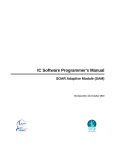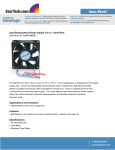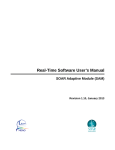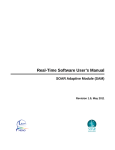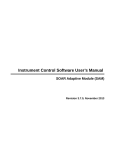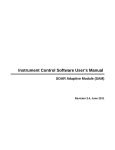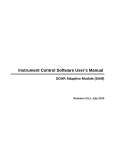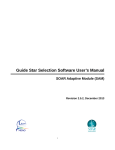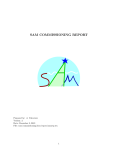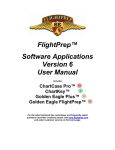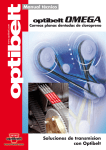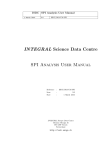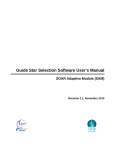Download 0.41M, PDF
Transcript
IC Software Programmer's Manual
SOAR Adaptive Module (SAM)
Revision Rev 3.6.4, February 2015
Change Record
Version
Date
3.5
March 14, 2013
3.6
March 25, 2013
Description
Modulate command documented
Owner Name
RCR
RCR
3.6.1
June 7, 2013
Add reference for LM M4 command
RCR
3.6.2
December 2, 2013
Refinements in section 4.1
RCR
3.6.3
February 12, 2015
Add missing RTC LLT options in section 3.1
RCR
3.6.4
February 17, 2015
Add reference to RMFAULTS command
RCR
ii
Table of Contents
Chapter 1: Overview..................................................................................................................................1
1.1Introduction......................................................................................................................................1
1.2Software Architecture.......................................................................................................................2
1.3Source Code.....................................................................................................................................2
Chapter 2: Manager Modules.....................................................................................................................4
2.1RTSOFT Control Manager...............................................................................................................4
2.2AOMSOFT Control Manager...........................................................................................................5
2.3SLGMSOFT Manager......................................................................................................................6
2.3.1Status Poll.................................................................................................................................6
2.4TCS Manager...................................................................................................................................9
2.5Execution Threads............................................................................................................................9
Chapter 3: Scripting.................................................................................................................................11
3.1Local Commands............................................................................................................................11
3.2Remote Commands........................................................................................................................20
3.2.1Instrument Command Handler...............................................................................................21
3.2.2GMAP Command Handler.....................................................................................................21
Chapter 4: Guide Star Acquisition...........................................................................................................23
4.1Interactive star selection in LGS Mode..........................................................................................23
Chapter 5: Range Gate.............................................................................................................................26
Chapter 6: Atmospheric Dispersion Correction.......................................................................................27
Chapter 7: Telemetry................................................................................................................................29
APPENDIX A: North-East coordinates to Up-Left coordinates for Gnomonic Projection.....................30
APPENDIX B: Up-Left coordinates to SAM Guide Probe coordinates.................................................33
APPENDIX C: Dispersion Orientation Angle.........................................................................................37
iii
Chapter 1: Overview
Chapter 1:
Overview
1.1 Introduction
The SAM software suite of applications comprises a set of programs that differentiate themselves by
the mission they serve [SDN-8201]. The suite includes the SAM Instrument Control Software
(ICSOFT), the SAM Imager Software (SAMI), the SAM Motion Control Software (AOMSOFT), the
SAM Laser Guide-Star Motion Control Software Module (SLGMSOFT), the Laser Clearance House
software and the SAM Real-Time Software (RTSOFT).
SAMI
Eth
ICSOFT(LABVIEW)
Eth
SCL Server
(TCP/IP)
SOAR TCS
SCRIPTING
ENGINE
GUI TAB 1
Eth
Eth
(www.lua.org)
GUI TAB 2
GUI TAB 5
GUI TAB 3
GUI TAB 6
GUI TAB 4
Command Parser
LGS Control Mngr
(SCL Client)
Eth
LMsoft
RTC Manager
(SCL Client)
Eth
RTSOFT
AOM Control Mngr
(SCL Client)
TCS Manager
(SCL Client)
Eth
AOMSOFT
Eth
Figure 1: Block diagram of the Instrument Control Software. Managers handle the remote systems and AO
subsystems. Managers are TCP/IP clients using the SOAR Communication Library
This manual covers implementation details of the Instrument Control Software (ICSOFT). The
manual is not focused on operational aspects of the software. For an operational focus please read the
Instrument Control Software User Manual instead.
1
ICSOFT Programmer Manual Rev 3.6.4, February 2015
Chapter 1: Overview
1.2 Software Architecture
The ICSOFT is a Labview application running as a supervisory control application (Figure 1). It is
based in several GUIs and managers. The GUIs deal with the operator while the managers handle the
remote systems and SAM subsystems (RTSOFT, AOMSOFT, SLGMSOFT, and TCS). Remote client
connections are also allowed by means of communication server tasks.
The managers act as clients using the SOAR Communication Library (SCL) infrastructure. The
managers encapsulate all what's specific to each system/subsystem: status polling loops, command
routing, etc. All managers follow the same state machine logic; the manager keeps running while
connected to its server. If the connection is broken the manager enters the re-connection state until it
re-connects or the application is terminated
The ICSOFT is capable of accepting remote procedure calls (RPC) from other systems acting as a
server using SCL over TCP/IP . The command interface is of the type: <command> <arg1> <arg2> ...
<argN>.
The ICSOFT provides several GUIs. A command parser routes the local commands from the GUIs
and script engine, as well as remote commands received by the SCL server, to the managers for actions
and status information.
1.3 Source Code
The ICSOFT software can be found in the Instrument Control Computer machine, installed in the ao
user home directory /home/ao under root directory ICsoft. The Labview application code lives under
subdirectory modules with its main VI living alone in the root directory ICsoft.
Executables and shared libraries produced can be found under directory bin and lib. Configuration
files, data files under directory config.
Copies of the ICSOFT are kept in the SOAR public repository. Access is possible through local
accounts on machine ctioll. The path to the copies is /home/public/SOAR/SAM.
The following is a tree view of the directory structure of the software:
Icsoft
|--bin
|--config
|--data
|--doc
|--lib
|--logs
|--modules
| |--AOMLib
| |--AstroLib
| |--HistoryLib
| |--ICSoftLib
| |--LGSLib
| |--ParseLib
| |--RTCLib
| |--SCLN
| `--TCSLib
ICSOFT Programmer's Manual Rev 3.6.4, February 2015
2
Chapter 1: Overview
|--macro
`--scritps
To access the code is recommended to start by opening the main VI first
% cd /home/ao/ICsoft
% labview Icsoft.vi
3
ICSOFT Programmer Manual Rev 3.6.4, February 2015
Chapter 2: Manager Modules
Chapter 2:
Manager Modules
Managers modules encapsulate all the specifics involved in the interaction with each SAM
subsystem: connection integrity, status polling loops, command routing, etc. All managers act as clients
using the SOAR Communication Library (SCL) infrastructure, and follow the same state machine
logic; the manager keeps running while connected to its server. If the connection is broken the manager
enters the re-connection state until it re-connects or the application is terminated. A status task within
the manager is in charge of continuously polling for status data from the server. The polling can be
activated/deactivated from the GUI for debugging purposes though. If a timeout occurs while waiting
for a status response from the server, the link to the server is automatically closed and a reconnection
cycle to the server starts up. Otherwise the response is passed to a parser VI that de-serializes the data
using a configuration file as a data mode definition. Each de-serialized sample is then analyzed to set
warnings and alarms accordingly.
FIXME: FILL HERE THE MISSING COMMAND ROUTING MECHANISM
2.1 RTSOFT Control Manager
The status task for the RTSOFT Control Manager (RTCM) polls for status every 1 second. The
configuration file defining the data structure exchanged between the RTSOFT and the ICSOFT is
rtc_status.cfg. The two files live in the Icsoft/config directory. Not all of the elements are considered. A
short description of the selected fields follows.
.
.
FIXME: FILL HERE THE MISSING FIELDS
.
.
[RGATE]
STATUS – ON or OFF.
MODE – AUTO or LASER.
DELAY – A fractional value in units of [ns]
DISTANCE – A fractional value in units of [ns]
PWIDTH – A fractional value in units of [ns]
PERIOD – A fractional value in units of [ns]
[LLT]
LOOP – ON or OFF.
PZT1OFFSET – A fractional value in units of [V].
ICSOFT Programmer's Manual Rev 3.6.4, February 2015
4
Chapter 2: Manager Modules
PZT2OFFSET – A fractional value in units of [V].
.
FILL HERE THE MISSING FIELDS
.
.
2.2 AOMSOFT Control Manager
The status task for the AOMSOFT Control Manager (AOMCM) polls for status every 1 second. The
configuration files defining the data structures exchanged between the AOMSOFT and the ICSOFT are
AOM_MechanismStatus_Default.cfg and SAM_TelemetryStatus_Default.cfg. The two files live in the
Icsoft/config directory. Not all of the elements are considered. A short description of the selected fields
follows.
.
.
FILL HERE THE MISSING FIELDS
.
.
[G_Dimmer_P1]
power – One of the strings ON or OFF.
status – One of the strings ENABLED or TBD.
dimmer - A numeric string between 0 and 100.
[G_Dimmer_P2]
power – One of the strings ON or OFF.
status – One of the strings ENABLED or TBD.
dimmer - A numeric string between 0 and 100.
[TS_Dimmer]
power – One of the strings ON or OFF.
status – One of the strings ENABLED or TBD.
dimmer - A numeric string between 0 and 100.
[WFS_Ref_Beam]
5
ICSOFT Programmer Manual Rev 3.6.4, February 2015
Chapter 2: Manager Modules
status – One of the strings “DONE”, “ACTIVE”, DISABLED” or TBD.
abs_position – One of the strings “IN”, “OUT” or “NONE”.
[WFS_f/10_Adj]
position – A fractional string expressing the current position in [mm].
status – One of the strings “DONE”, “ACTIVE”, DISABLED” or TBD.
[WFS_Dimmer]
power – One of the strings ON or OFF.
status – One of the strings ENABLED or TBD.
dimmer - A numeric string between 0 and 100.
.
.
FILL HERE THE MISSING FIELDS
.
.
[Sam_Cover]
position - One of the words OPEN, OUT OF TBD, or CLOSE
status - One of the strings ENABLED or TBD.
2.3 SLGMSOFT Manager
VI Name: lm_manager
Module Name: LMLib
2.3.1 Status Poll
VI Name: lm_manager_status_poll
The status task for the SLGMSOFT Manager (SLGMM) polls for status every 1 second. The
configuration file defining the data structure exchanged between the SLGMSOFT and the ICSOFT is
LGS_Full_Status.cfg. The file lives in the ICsoft/config directory. Not all of the elements are considered
to be stored in type II global variables. A short description of the selected fields follows.
[LASER]
Diode On/Off (Standby) – One of the strings “ON”, “OFF” or “STANDBY” describing the
status of the LASER diode.
ICSOFT Programmer's Manual Rev 3.6.4, February 2015
6
Chapter 2: Manager Modules
Laser Power – A fractional string with the LASER power in units of [WATT]
Fault Status – One of the strings TBD describing fault conditions.
Chiller Temperature – A fractional string with the chiller working temperature.
Shutter – One of the strings TBD describing the state of the LASER shutter.
[M1_X]
position_X – A fractional string expressing the LLT M1 current x position in [mm].
status – One of the strings “DONE”, “ACTIVE”, DISABLED” or TBD.
[M1_Y]
position_Y – A fractional string expressing the LLT M1 current y position in [mm].
status – One of the strings “DONE”, “ACTIVE”, DISABLED” or TBD.
[M2_Focus]
position – A fractional string expressing the LLT M2 current position in [mm]
status – One of the strings “DONE”, “ACTIVE”, DISABLED” or TBD.
[LLT_Cover]
position – A fractional string expressing the LLT cover current position in TBD units.
status – One of the strings “DONE”, “ACTIVE”, DISABLED” or TBD (TBC)
abs_position – One of the strings “OPEN” or “CLOSED”.
[LaserSelect]
status - One of the strings DONE, ACTIVE, DISABLED or TBD indicating the status of the
LASER selector mechanism.
abs_position – One of the strings IN or OUT indicating the position of the mechanism.
[LLTDigitalIO]
Prosilica – One of the strings ON or OFF indicating the state of the LLT ATP camera.
LaserDiode – One of the strings ON or OFF indicating the state of the LLT LASER diode.
LLTMotors – One of the strings ON or OFF indicating the LLT motors power supply status.
FANPower – One of the strings ON or OFF indicating the LLT fan status.
7
ICSOFT Programmer Manual Rev 3.6.4, February 2015
Chapter 2: Manager Modules
status – One of the strings DONE or TBD.
[LLTAnalogInput]
LLT_Temp – A fractional string expressing the current LLT temperature in units of [C]
Prosilica – A fractional string expressing the current voltage applied to the camera in units of
[V].
LaserDiode – A fractional string expressing the current voltage applied to the LLT LASER
diode in units of [V].
status – One of the strings “DONE” or TBD.
[LaserDigitalIO_B]
Interlock – One of the strings TBD or TBD indicating if an interlock has been engaged.
Heater – One of the strings ON or OFF indicating the state of the LASER box heater.
SafetyShutter_In – Laser box safety shutter IN limit switch status.
SafetyShutter_Out – Laser box safety shutter OUT limit switch status.
[PiezoAnalogInput]
PZT1 – A fractional string expressing the current voltage applied to the PZT1 in units of [V]
Input1 – A fractional string
PZT2 – A fractional string expressing the current voltage applied to the PZT2 in units of [V]
Input2 – A fractional string
PZT3 – A fractional string expressing the current voltage applied to the PZT3 in units of [V]
Input3 – A fractional string
status – One of the strings DONE, DISABLE or TBD.
[TempLaserBox]
temperature – A fractional string expressing the current temperature inside the laser box.
[IBOOT]
state – One of the strings ON or OFF indicating the state of the LASER box 220[V] remote
power outlet.
ICSOFT Programmer's Manual Rev 3.6.4, February 2015
8
Chapter 2: Manager Modules
2.4 TCS Manager
INFO
ROTSPOS RMA IAA GUI_XY CCD_XY M3_POS
Rotator mechanical angle
Instrument Position Angle
Instrument Alignment Angle
Angulo del guider con respecto al rotador
Angulo del CCD con respecto al rotador
Position del M3 (1 Nasmyth Right (infrared), 2 Bent Cass 1, 3 CWFS Bent Cass 2, 4 SOI Bent Cass 3,
5 Nasmyth Left (vosible)
2.5 Execution Threads
Table 1 lists the ICSOFT VIs and their execution thread and priority. The descendant VIs are all
marked to run in the execution thread of their parents.
9
ICSOFT Programmer Manual Rev 3.6.4, February 2015
Chapter 2: Manager Modules
Table 1: Execution thread and priority assignments. Descendants are marked to run in the execution thread of their parents.
Vi Name
ICsoft
Queue
1
Running
Thread
Priority
Description
Always
User Interface
Normal Main VI
hist_task
Always
User Interface
Normal Log alarms and events
parse_task
Always
User Interface
Normal Parse and execute string commands
icsoft_task_update_connections
Always
User Interface
Normal Poll for all remote connection status
icsoft_task_command_servers
2, 3
Always
User Interface
Normal Incoming connections
icsoft_task_adc_logic
ADC
Always
Standard
Normal ADC corrections
tcs_task_manager_launcher
Mq1
Always
Data Acquisition Normal TCS manager
aom_task_manager_launcher
Mq2
Always
Data Acquisition Normal AOM manager
rtc_task_manager_launcher
Mq3
Always
Data Acquisition Normal RTC manager
lm_task_manager_launcher
Mq4
Always
Data Acquisition Normal LGS manager
ICSOFT Programmer's Manual Rev 3.6.4, February 2015
10
Chapter 3: Scripting
Chapter 3:
Scripting
The ICSOFT integrates the LuaView engine (luaview.esi-cit.com) to handle scripting. For details on
the LUA scripting language visit the web site www.lua.org.
The LUA interface provides just two commands: sam.command and sam.wait_until_end. Read
section 3.1 below for a list of the available commands to be passed as arguments to the LUA interface.
Here is part of the GP1-tune.lua script for reference on how to use them
% cat /home/ICsoft/scripts/GP1tune.lua
-- Test GP1 centering
ok, flux = sam.command("GET RTC TT GP1F")
sam.command("LOG GP1flux is " .. flux)
fluxmin = 5.
if (flux + 0) < fluxmin then
sam.command("LOG Flux less than " .. fluxmin ..", returning")
return
end
.
.
.
-- Move the GP and take error signals
sam.command("LOG Moving probe to " .. x2 .. "
" .. y2)
sam.wait_until_end("AOM GUIDERP1 MOVE " .. x2 .." " .. y2, 25000)
ok, ex2 = sam.command("GET RTC TT GP1X")
.
.
.
3.1 Local Commands
ADC <MOVE | ENABLE | DISABLE>
MOVE <INNER> <OUTER> - With no arguments use mount elevation angle to obtain
the prism angles.
AOM <GUIDERP1 | GUIDERP2> - Forward Guide Probe commands to AOMSOFT.
GUIDERP<N> STOP
GUIDERP<N> MOVE XP YP <ZP>
GUIDERP<N> DIMMER [ON | OFF]
GUIDERP<N> DIMMER MOVE [0-100]
AOM TURSIM - Forward TURSIM commands to AOMSOFT.
11
ICSOFT Programmer Manual Rev 3.6.4, February 2015
Chapter 3: Scripting
TURSIM PHSCREEN<N> MOVE [IN | OUT]
TURSIM PHPLATE<N> MOVE [0-100]
TURSIM INJARM MOVE [IN | OUT]
TURSIM DIMMER [ON | OFF]
TURSIM DIMMER MOVE [0-100]
TURSIM SJOGX [0 | 1]
TURSIM SJOGY [0 | 1]
AOM WFS - Forward Wave Front Sensor commands to AOMSOFT.
WFS FOCUS MOVE FP
WFS REFBEAM MOVE [IN | OUT]
WFS DIMMER [ON | OFF]
WFS DIMMER MOVE [0 – 100]
AOM <ESHUTTER | ADC | OUTSEL> - Environmental shutter, Atmospheric Dispersion
Correction, and Output Selector Mirror.
ESHUTTER MOVE [OPEN | CLOSE]
ADC MOVE [IN | OUT | STOP]
ADC MOVE INNER OUTER
OUTSEL MOVE [IN | OUT]
AOM <APD | ACAM | HV > - Avalanche Photo Diodes, Acquisition Camera, and Pockell Cell
High Voltage.
APD<N> [ON | OFF | RESET]
ACAM [ON|OFF] – Turn the WFS acquisition camera power on-off.
HV [ON|OFF] – Turn the Pockel-Cell high voltage on-off.
AOM <STATUS | TELEMETRY>
STATUS
TELEMETRY
ECHO <ARG1> <ARG2> ... <ARGN> - Simply returns the arguments back to the originator.
GET RTC
RTC RTC [FAULT | LSFAULT | SIMM | MODE|STATE]
RTC WFS [RGATE | RGDELAY | STATUS | MIN | MAX | MEAN | STDEV | ETIME |
ICSOFT Programmer's Manual Rev 3.6.4, February 2015
12
Chapter 3: Scripting
MEANFLUX | BIAS | BGND]
RTC AO [LOOP | LTIME | R0 | V | VCM]
RTC TT [LOOP | CTLR | FULLBW | LTIME | GP1F | GP2F | GP1W | GP2W | GP1X |
GP1Y | GP2X | GP2Y | GP1LOCK | GP2LOCK]
RTC MOUNT [LOOP]
RTC LLT [LOOP | CTLR | PZT1OFFSET | PZT2OFFSET]
GET AOMS1
AOMS Guider_P1_X [position|pos_zpoint|status]
AOMS Guider_P1_Y [position|pos_zpoint|status]
AOMS Guider_P2_X [position|pos_zpoint|status]
AOMS Guider_P2_Y [position|pos_zpoint|status]
AOMS Focus_P1 [position|status|init]
AOMS Focus_P2 [position|status|init]
AOMS G_Dimmer_P1 [power|status|dimmer]
AOMS G_Dimmer_P2 [power|status|dimmer]
AOMS Output_Selector [position|status|abs_position|trajectory|init]
AOMS TS_Ph_Screen_1 [position|status|abs_position]
AOMS TS_Ph_Screen_2 [position|status|abs_position]
AOMS TS_Source_Adj_X [position|status|abs_position]
AOMS TS_Source_Adj_Y [position|status|abs_position]
AOMS TS_Dimmer [power|status|dimmer]
AOMS TS_Phase_Plate [ph_plate1_status|ph_plate1_vel]
AOMS TS_Phase_Plate [ph_plate2_status|ph_plate2_vel]
AOMS TS_Phase_Screen [screen1_pos|screen2_pos|power1|power2|status1|status2]
AOMS TS_Source_Adj [s_adjx_status|s_adjy_status|sourcex_vel|sourcey_vel]
AOMS TS_Inj_Arm [position|power|status]
AOMS Filter_Wheel [position|status]
AOMS WFS-Focus [position|status|abs_position|init]
AOMS WFS_Ref_Beam [position|power|status]
1 The parameters listed here correspond to the status definition contained in configuration file
AOM_MechanismStatus_Default.cfg
13
ICSOFT Programmer Manual Rev 3.6.4, February 2015
Chapter 3: Scripting
AOMS WFS-Dimmer [power|status|dimmer]
AOMS ADC-Inner [position|status|init]
AOMS ADC-Outer [position|status|init]
AOMS ADC_Position [position|abs_position|status|init]
AOMS Fabri-Perot [position|abs_position|status|init]
AOMS Sam_Cover [position|status]
AOMS SHUTTER [position|status]
GET AOMT2
AOMT PowerSupply
[Telemetry|APD1_30V|APD2_30V|APD_5V|APD_2V|Reserved_01]
AOMT PowerSupply [Prosilica_12V|Prosilica|Reserved_03|Control|APD1|APD2]
AOMT PowerSupply [Overcurrent_APD1| Overcurrent_APD2]
AOMT HV [Pockels_Power_supply|HV_value|HV_Error]
AOMT HV [status]
AOMT Temperatures [Glycol|OAP1_area|DM_area|OAP2_area|ADC_area]
AOMT Temperatures [Tursim_area | status]
GET LMS3
LMS LASER [Diode On/Off (Standby) | Laser Power | Interlock | Fault Status]
LMS LASER [Diode Current Setting | Diode Temperature Sense]
LMS LASER [Chiller Temperature | Shutter | RF Level]
LMS LASER [Flow Switch | Set Trigger Mode]
LMS M4_Axis_1 [position | status | init]
LMS M4_Axis_2 [position | status | init]
LMS M1_X [position | position_X | status | init]
LMS M1_Y [position | position_Y | status | init]
LMS M2_Focus [position | status | init]
LMS LLT_Cover [position | status | init | abs_position]
LMS LaserSelect [position | status | init | abs_position]
2 The parameters listed here correspond to the status definition contained in configuration file
SAM_TelemetryStatus_Default.cfg
3 The parameters listed here correspond to the status definition contained in configuration file LGS_Full_Status.cfg
ICSOFT Programmer's Manual Rev 3.6.4, February 2015
14
Chapter 3: Scripting
LMS LLTDigitalIO [Prosilica | LaserDiode | status]
LMS LLTDigitalIO [LLTMotors] – LLT motors power supply status [ON | OFF]
LMS LLTDigitalIO [FANPower] – LLT fan status [ON | OFF]
LMS LLTAnalogInput [PhM1-X1 | PhM1-X2 | PhM1-Y1 | PhM1-Y2 | PhM2]
LMS LLTAnalogInput [LLT_Temp | Prosilica | LaserDiode | LLTMotors | FANPower]
LMS LLTAnalogInput [status]
LMS LaserDigitalIO_A [FloodDetector | EmergencyChiller | EmergencyLaserDoor]
LMS LaserDigitalIO_A [EmergencyConsole | SLCHCommFail | RS485CommFail]
LMS LaserDigitalIO_A [status]
LMS LaserDigitalIO_B [Key_interlock | Interlock]
LMS LaserDigitalIO_B [SafetyShutter_In] – Laser box safety shutter status
LMS LaserDigitalIO_B [SafetyShutter_Out] – Laser box safety shutter status
LMS LaserDigitalIO_B [Watchdog_Monitoring | Heater | GreenLaser | status]
LMS IBOOT [state] – Remote power outlet status [ON | OFF]
LMS PiezoAnalogInput [PZT1 | Input1 | Voltage | PZT2 | Input2 | PZT3 | Input3]
LMS PiezoAnalogInput [status]
LMS TempLaserBox [temperature | setpoint | status | heater]
GET TCS
15
TCS POSANG
Position angle in degrees
TCS RMA
Rotator mechanical angle in degrees
TCS M3POS
M3 turret position.
TCS RA
Telescope right ascension
TCS DEC
Telescope declination
TCS HA
Telescope hour angle
TCS AZ
Telescope azimuth
TCS ZD
Telescope zenith distance
TCS EL
Telescope elevation
TCS EPOCH
Coordinates epoch
TCS LST
Siderial time
TCS DITHER
Dither value in numeric control.
ICSOFT Programmer Manual Rev 3.6.4, February 2015
Chapter 3: Scripting
TCS FOFFSET
Telescope offset value in numeric control.
INFO - This command will return a string of the form “DONE VAR1=VAL1 VAR2=VAL2”
containing status information of the SAM instrument. The data included is
OPMODE
SAM operation mode: TSNGS, NGS, TSLGS or LGS
R0
Estimated Fried parameter in [m]
WSPEED
Estimated wind speed in [m/s]
VARCM
Variance of corrected modes in [rad^2]
INSTRMT
Name of selected instrument: SAMI, VISITOR, etc.
DMLOOP
DM mirror loop ON or OFF
FTIME
Frame time in [ms]
WFSFLX
WFS flux in [Ke-/s] per sub-aperture
WFSFOC
WFS focus in [mm]
M3LOOP
M3 mirror loop ON or OFF
APDTIME
APDs sample time in [ms]
APDHV
APDs high voltage ON or OFF
P1LIGHT
Guide probe 1 light ON or OFF
P2LIGHT
Guide probe 2 light ON or OFF
MNTLOOP
Mount loop ON or OFF
LLTLOOP
LLT loop ON or OFF
RGPOWER
Range gate power ON or OFF
RGDELAY
Range gate delay in [ns]
LGSDIST
Laser guide star distance in [Km]
LQUALTY
Laser quality
LPOWER
Laser power ON or OFF
LSHUT
Laser intra cavity shutter OPEN or CLOSE
LLTDOOR
Launch laser telescope environmental door OPEN or CLOSE
ADC
ADC compensation ON or OFF
ADCIN
ADC inner element position
ADCOUT
ADC outer element position
VIFOLD
Visitor instrument fold IN or OUT
ICSOFT Programmer's Manual Rev 3.6.4, February 2015
16
Chapter 3: Scripting
REFLIGHT
WFS reference light ON or OFF
REFARM
WFS reference arm IN or OUT
TSDISK
TURSIM disk rotation ON or OFF
TSFOLD
TURSIM fold IN or OUT
TSLIGHT
TURSIM light ON or OFF
MODDOOR Environmental module door OPEN or CLOSE
LM <M1 | ... > - Forwards commands to the LMSOFT.
ATP [ON | OFF]
M1 MOVE <M1X> <M1Y> - M1X and M1Y in units of [mm]
M2 MOVE <VALUE> - VALUE in units of [mm]
M4 MOVE <A1> <A2> - A1 and A2 in the rage [-1, 1]
SAFETYSHUTTER MOVE [IN | OUT]
LM
LLT - Forward Laser Launch Telescope commands to LMSOFT.
LLT FAN [ON | OFF]
LLT POWERSUPPLY [ON | OFF]
LLT SHUTTER [OPEN | CLOSE]
LM
LASER - Forward Laser Box commands to LMSOFT.
LASER DIODE [ON | OFF]
LASER POWERSUPPLY [ON | OFF]
LASER SHUTTER [OPEN | CLOSE]
LOG <ARG1> <ARG2> ... <ARGN> - Log the arguments to the ICSOFT log file and to the
Events and Messages display.
RMFAULTS – Use this command to clear all faults latched by the system. If the ALARM led
indicator in the ICSOFT is lite, it will have the effect of turning that light off.
RTC <AO | DM | TT | ... > - Forwards commands to the RTSOFT.
AO <OPEN | CLOSE | STATE > - Open/Close the AO loop.
17
ICSOFT Programmer Manual Rev 3.6.4, February 2015
Chapter 3: Scripting
BGND <ON | OFF> - WFS background subtraction.
BIAS <ON | OFF | ACQ | APPLY | STATE > - WFS bias subtraction control.
ACQ <frames> - Takes a WFS bias calibration by averaging frames number of
frames and then save the result to disk using two names: the protected name
wfsbias.fits and the date formatted name wfsbias-YYYYMMDDTHHMMSS.fits
APPLY – Loads the file wfsbias.fits from disk and sets the RTCORE to use it.
CAMERA <exposure | ldf | power | readout | reset | set | mancmd | STATE >
exposure [stop|abort]
ldf [util|pci|tim]
power [on|off]
readout[abort|stop-idle]
set binning <val1> <val2>
set exposure <val>
set frames <val>
set gs <val1> <val2>
set readout <val>
set size <val1> <val2>
set trigger <val>
set roi <val1> <val2> <val3> <val4>
set panoramic]
DM <APPLY | FLATTEN | RECFLAT | ROTFLAT | STATE>
FLATTEN – Load and apply the voltages stored in the file flattendm.cfg to the
DM.
APPLY <V0 V1 V2 ...... V59> – Apply the given voltages to the DM.
RECFLAT – Save the currently applied DM voltages to disk using the protected
name flattendm.cfg and flattendm-YYYYMMDDTHHMMSS.cfg
ROTFLAT – Load and apply the voltages stored in the file flattendm.cfg
including a correction factor based on the current Nasmyth rotator mechanical
angle, and coefficients in file DMflat_rot.txt. See the RTSOFT programmer's
manual for a detailed description.
ECHO <ARG1> <ARG2> ... <ARGN> - Return all arguments.
EXEC <MACRO> - execute the specified macro.
FLATTEN – Deprecated, use “DM FLATTEN” instead.
LOAD [APDMAP | WMAT | XGRID | YGRID]
ICSOFT Programmer's Manual Rev 3.6.4, February 2015
18
Chapter 3: Scripting
APDBIAS <FILENAME> - Load the bias for each APD.
APDMAP <FILENAME> - Loads the quad sensor geometry
WMAT <FILENAME> - Load the weights for WcoG.
XGRID <FILENAME> - Load x relative positions for WcoG.
YGRID <FILENAME> - Load y relative position for WcoG.
LLTM1 <CLOSE | OPEN> - LLT M1 loop control.
LLTM3 <CLOSE | DISABLE | ENABLE | OPEN> - LLT M3 loop control.
M3 <CLOSE | DISABLE | ENABLE | OPEN> - M3 loop control.
MODE <TSNGS | NGS | TSLGS | LGS> - Set RTC operation mode.
MODULATE RADIUS PERIOD CYCLES MOUNT <CLOSE | OPEN> - Mount loop control.
REC FRAMES AOPERIOD TTPERIOD – Use this command to record FRAMES
number of wavefront sensor frames, AOPERIOD seconds of AO loop data, and
TTPERIOD seconds of tip tilt loop data. With no arguments the default values are used.
Set argument to a negative number to skip recording data for it. The command produce
four files:
WF-YYYYMMDDTHHMMSS.RAW
WF-YYYYMMDDTHHMMSS.FITS
AO-YYYYMMDDTHHMMSS.DAT
TT-YYYYMMDDTHHMMSS.DAT
The files are saved to an automatically generated subdirectory located in a root directory
set in the RTSOFT configuration file.
RGATE <ON | OFF | MODE | DELAY | DISTANCE | PWIDTH | PPERIOD>
MODE <AUTO | LASER> - Use to select between AUTO and LASER sync
modes for ON/OFF pulse generation.
DELAY <VALUE> - In LGS mode the delay in [ns] between the falling edge of
the TRIGGER OUT signal and the ON pulse to the Pockels Cell high-voltage
driver.
DISTANCE <VALUE> - The delay in [ns] between the falling edge of the ON
pulse and the rising edge of the OFF pulse to the Pockels Cell high voltage
driver.
PWIDTH <VALUE> - The width on [ns] for the ON and OFF pulses to the
Pockels Cell high-voltage driver.
PPERIOD <VALUE> - In TSLGS mode the time period in [ns] of the
19
ICSOFT Programmer Manual Rev 3.6.4, February 2015
Chapter 3: Scripting
pulse-train.
RMFAULT – Clear alarms.
RNOISE <ADU> - Set the readout noise value in the RTCORE. If the max value in a
sub-aperture is smaller than three times this value, then the slopes are discarded and zero
is returned instead.
RT <ARG1> <ARG2> ... <ARGN> - RTCORE interface.
SDSU <ARG1> <ARG2> ... <ARGN> - LEACH II controller interface.
SETREF < REVERT | OFFSET> - Without arguments attempts to measure the
reference positions for each sub aperture.
REVERT - Use the revert option to remove all user applied offsets to the
measured reference positions.
OFFSET < ID | IDN-IDM >
ID <OX> <OY> - Add a user defined offset to sub aperture ID. Without
arguments return the current offset by subtracting the measured reference
position to the current reference position value.
IDN-IDM <OX> <OY> - Add a user defined offset to a range of sub
apertures starting at IDN and ending at IDM.
SLEEP <VALUE> - Wait a number of milliseconds and return.
SYTEM <ARG1> <ARG2> ... <ARGN> - RTC OS command.
TT <PSCALE | PWEIGHT | LOCK>
PSCALE <VALUE> - Set the seeing dependent coefficient that relates TT probes
error signals to actual displacements in arc-seconds.
PWEIGHT <VALUE> <VALUE> - Set the weight for each guide probe error
signal.
LOCK <0 | 1> <0 | 1> - Control guide probe locking.
TTBIAS < ON | OFF | WHO | STATE >
<WHO> <SAMPLES> – Use to select the number of counts to average to estimate the
APD bias. Max number is 6000 and min number is 50. Valid values for argument WHO
are 0: BOTH, 1: GP1 only, 2: GP2 only.
TTP1, TTP2 [OPEN | CLOSE] Open/Close the TT loop for probe 1 or 2.
ROTFLAT <ANGLE> - Flatten the DM according to the specified rotator angle. With no
arguments it uses the current rotator angle as published by the TCS. If the TCS is not available a
rotator angle of 0 is used instead.
TCS <ARG1> <ARG2> ... <ARGN> - Forward commands to the TCS.
TCS GET
ICSOFT Programmer's Manual Rev 3.6.4, February 2015
20
Chapter 3: Scripting
3.2 Remote Commands
These are command available only to remote applications connecting to the ICSOFT through one of
its three command servers. Two of the servers have at their core the
parse-service-instrument-command VI. The third one is GMAP 4 specific and implemented by the
parse-service-gmap-command VI.
3.2.1 Instrument Command Handler
VI Name
: parse-service-instrument-command
Module
: PARSELIB
Default behavior is to forward the command to the ICSOFT command parser in parse_task.vi and
return immediately with the response.
AO [OPEN | CLOSE] - Open/Close the AO loop by executing the script aoloop_close.lua and
aoloop_open.lua
AOM [P1 | P2] - Return the current X-Y coordinates for guide probe 1 or 2.
ECHO - see section 3.1 above for a complete description.
GET - see section 3.1 above for a complete description.
INFO - see section 3.1 above for a complete description.
PING - replies the string “SAM INSTRUMENT CONTROL APPLICATION”
SOFFSET SX SY [SAMI] – set the offset between a reference star and the center of the field
in units of arc-seconds in the X-Y GP coordinate frame . Parameters SX and SY are in units of
arc-seconds. If the third argument SAMI is specified SX and SY are assumed to be X-Y SAMI
CCD coordinates in units of pixels (no binning), and translated to X-Y GP coordinates. See
section 4.1 below for more details on how this command is implemented.
3.2.2 GMAP Command Handler
ECHO - see section 3.1 above for a complete description.
GC - Returns the current RA-DEC mount coordinates.
GP - Returns the current Rotator Mechanical Angle.
GPOFFSET <XOFFSET> <YOFFSET> - Set the offset in arc-seconds between the mount
coordinates and the center of the field.
P1 [XYSTATUS | COORDS]
P2 [XYSTATUS | COORDS]
XYSTATUS - X-Y coordinates of guide probe 1 in arc-seconds using the GMAP X-Y
reference system. In that frame XGMAP is flipped with respect to XSAM. The XYSTATUS
command account for that flip and returns the correct sign to GMAP.
4 Guide Star Selection Tool
21
ICSOFT Programmer Manual Rev 3.6.4, February 2015
Chapter 3: Scripting
COORDS HH:MM:SS DD:MM:SS Epoch – Set the ICSOFT next object
RA-DEC-EPOCH variables. The next object coordinates can be then be used for guide
star acquisition see section TBD.
SOFFSET SX SY [SAMI] – set the offset between a reference star and the center of the field
in units of arc-seconds in the X-Y GP coordinate frame . Parameters SX and SY are in units of
arc-seconds. If the third argument SAMI is specified SX and SY are assumed to be X-Y SAMI
CCD coordinates in units of pixels (no binning), and translated to X-Y GP coordinates. See
section 4.1 below for more details on how this command is implemented.
ICSOFT Programmer's Manual Rev 3.6.4, February 2015
22
Chapter 4: Guide Star Acquisition
Chapter 4:
Guide Star Acquisition
Guide star acquisition involves transforming RA-Dec coordinates to X-Y stages coordinates in
[mm]5. The required functionality for doing the transformations is provided by the ASTROLIB library
of VIs. The library was contributed by SOAR and is part of the SOAR TCS application suite.
The ICS accepts target coordinates for the probe expressed in RA-Dec plus epoch. The
transformations are encapsulated in icsoft_general_GRA_GXY.vi. The VI accepts as input the target
RA-Dec coordinates and returns as output the X-Y coordinates of the guide star.
The process starts by moving the input coordinates to the epoch reported by the TCS. The resulting
RA-Dec coordinates along with the Mount coordinates are used to obtain the gnomonic projection
coordinates and ( is in the east axis and is in the north axis).
Then the transformations that account for the optical system of the telescope are applied [see
appendix A below]. Here those transformation are presented in their matrix form
[] [
][
][
][
][ ]
x = cos ROT −sin ROT cos −EL −sin −EL −1 0 cos −sin
y
sin ROT cos ROT sin−EL cos −EL 0 −1 sin cos
The coordinates in units of [mm] are obtained multiplying x and y by the focal length of the
telescope. Finally the field center6 offset and the quad sensor offsets are added.
While the field center offset changes depending on how bad the mount pointing is, the quad sensor
offsets are fixed.
4.1 Interactive star selection in LGS Mode
In LGS mode we use SAMI to help calibrate the guide star selection tool GMAP. SAMI allows to
interactively select a star from an image and send its coordinates to the ICSOFT. By using the known
coordinates of the field-center in SAMI plus the field rotation and the scale, the ICSOFT calculates the
offset between the selected star and the field-center in units of arc-seconds in the X-Y GP coordinate
frame.
DX = SAMISCALE×STARX −SAMIFCX
DY = SAMISCALE×STARY −SAMIFCY
SOFFSETX = DX×cos SAMIROT − DY ×sin SAMIROT
SOFFSETY = DX×sin SAMIROT DY ×cos SAMIROT
(4.1)
5 Looking SAM from the ISB, X is parallel to the bench and positive right. Y is perpendicular to the bench and positive
up.
6 Distance between the position where the mount is pointing and the position where the WFS field center is.
23
ICSOFT Programmer Manual Rev 3.6.4, February 2015
Chapter 4: Guide Star Acquisition
SAMI send the star coordinates issuing the SOFFSET command with the SAMI option at the end to
accept SAMI CCD coordinates. Upon receiving that command the ICSOFT calculates the offset
between the field center and the star (SOFFSETX, SOFFSETY) using the values stored in the icsoft.ini
configuration file: SAMIFCX, SAMIFCY, SAMIROT and SAMISCALE (4.1).
g
s
o = g − s
o
Figure 2: The cross mark the telescope coordinates in the sky-map. The circle is the selected star. The
triangle is the field center.
The user has to set GMAP sky map to display the observed field and find the selected star to click in
it. Correct identification of the selected star is critical to a good result. Then by pressing the FO button,
GMAP interrogates ICSOFT on the current value of (SOFFSETX, SOFFSETY), calculates the offset
between the mount and the field-center (GPOFFSETX, GPOFFSETY) and sends that value back to the
ICSOFT. Next time you command ICSOFT to acquire a star the following transformation will be made
to obtain the exact X-Y GP coordinates:
GPX ' = FLENGTH ×{ cos SAMPA − sin SAMPA }
GPY ' = FLENGTH ×{ sin SAMPA cos SAMPA }
(4.2)
GPX = GP1X ' GPOFFSETX GPAPDX OPOFFSETX
GPY = GP1Y ' GPOFFSETY GPAPDY OPOFFSETY
(4.3)
The keywords FLENGTH, GPAPDX, GPAPDY, OPOFFSETX and OPOFFSETY are defined in the
icsoft.ini configuration file. It is possible to GET/SET them on the fly via the GET/SET interface
commands.
ICSOFT Programmer's Manual Rev 3.6.4, February 2015
24
Chapter 5: Range Gate
Chapter 5:
Range Gate
Here is how the Range Gate parameters are calculated from the two parameters LGS Distance d and
LGS Gate g (Figure 3) in units of [Km]
d
g
Figure 3: Range Gate parameters are calculated from the two parameters LGS Distance d and LGS Gate g.
From the RTSOFT programmer manual, we need to set the DELAY and DISTANCE parameters.
DELAY is the delay in [ns] between the falling edge of the LASER sync pulse and the ON pulse to the
Pockels Cell driver. DELAY is obtained then as
DELAY =
2
g
× d −
c
2
(5.1)
where c is the speed of light in units of [Km/ns].
DISTANCE is the delay between the falling edge of the ON pulse and the rising edge of the OFF
pulse to the Pockels Cell driver.
DISTANCE = 2 ×
g
− Pulse Width
c
(5.2)
Since the Pockels Cell opens on rising edge the Pulse Width has to be taken into account.
25
ICSOFT Programmer Manual Rev 3.6.4, February 2015
Chapter 6: Atmospheric Dispersion Correction
Chapter 6:
Atmospheric Dispersion Correction
The ADC task is implemented by the icsoft_task_adc_logic VI. The VI loops waiting for input in the
ADC Task Queue . If the MOVE command arrives, the task searches for two arguments containing the
target positions for the prisms. The arguments are used to build the command “AOM ADC MOVE
ARG1 ARG2” and the resulting string is then sent to the AOMSOFT.
If the GO command arrives instead, the task uses the current telescope elevation (EL) and Nasmyth
rotator mechanical angle (ROT), as stated by the TCS, to obtain the target position for the prisms. The
process starts in the VI icsoft_calculate_dispersion_angle by obtaining the dispersion orientation angle
(DA) for the ADC [see Appendix C].
The dispersion orientation angle along with the zenith distance (ZD = 90 - EL) is then passed to the
VI icsoft_compute_adc_elements_position to obtain the final target positions for the inner element
(INNER) and the outer element (OUTER) of the ADC as
if (STRENGTH*tan(zd) < 1)
ANGLE = 90.0 - RAD2DEG( asin(STRENGTH*tan(zd)) );
else
ANGLE = 90.0
DA
= DA0 * SIGN + OFFSET;
INNER = DA – ANGLE;
OUTER = DA + ANGLE;
The two angles are then used to build the command “AOM ADC MOVE INNER OUTER” and the
resulting string is sent to the AOMSOFT. OFFSET, SIGN and STRENGTH are user defined parameters
obtained from the icsoft.ini configuration file.
When ADC compensation is enabled, the GO command executes every TIMEOUT seconds,
triggered by a loop in the VI icsoft_task_control_manager. TIMEOUT is a user defined parameter
obtained from the icsoft.ini configuration file.
27
ICSOFT Programmer Manual Rev 3.6.4, February 2015
Chapter 7: Telemetry
Chapter 7:
Telemetry
The icsoft_task_telemetry VI runs every second and checks for every test-point if LTIME seconds
have elapsed since the last check. The list of test-points to check is defined in the telemetry.ini file and
LTIME is a test-point user defined parameter.
Each test-point in the telemetry.ini file has an ID. The assignment between ID and telemetry channel
is hardwired into the code (Table 2)
Table 2: Test-point ID assignments
ID
29
Global Variable
Telemetry Keyword
0
TCHANNEL 00
30V Power Supply
1
TCHANNEL 01
30V APD 1
2
TCHANNEL 02
30V APD 2
3
TCHANNEL 03
5V APD
4
TCHANNEL 04
2V APD
5
TCHANNEL 05
Glycol
6
TCHANNEL 06
OAP1
7
TCHANNEL 07
DM
8
TCHANNEL 08
OAP2
9
TCHANNEL 09
ADC
10
TCHANNEL 10
TURSIM
11
TCHANNEL 11
PROSILICA 12V
12
TCHANNEL 12
Pockels-Cell High-Voltage
13
ATP 12V
14
LLT LASER Diode
ICSOFT Programmer Manual Rev 3.6.4, February 2015
APPENDIX A: North-East coordinates to Up-Left coordinates for Gnomonic Projection
APPENDIX A: North-East coordinates to Up-Left
coordinates for Gnomonic Projection
+
Up
North
ξ
θ
η
Left
East
Figure 4: View of the celestial sphere from the outside. is the angle between the plane containing the major circle
of the reference RA and major circle of the reference AZ.
The east-north coordinates ( is east) for the gnomonic projection of an object ( ) near the
reference coordinate (Z , Z) is given by
cos c = sinsin Z cos cos Z cos−Z
=
cos sin−Z
cos c
=
sin cos Z – cos sin Z cos−Z
cos c
(1)
To move the above coordinates to the Up-Left reference frame, they have to be rotated by the angle
between the North and Up vectors. That angle is obtained using the following algorithm for a given
geographic latitud , refence declination Z and reference hour angle H
z = cos , 0, sin , m
= cos −H cos Z , sin −H cos Z , sin Z , p = 0, 0, 1
Vector z is the zenith, m is the reference and p is the pole. Vector l is the normal vector defining the
plane containing the major circle of AZ. Vector e is the normal vector defining the plane containing the
major circle of RA.
Using the cross and dot product between the two normal we obtain the tangent of angle .
ICSOFT Programmer's Manual Rev 3.6.4, February 2015
30
APPENDIX A: North-East coordinates to Up-Left coordinates for Gnomonic Projection
l = z × m
e = p × m
∥l × e∥
l ⋅ e
tan =
(2)
m
⋅ l × e 0 ⇒ = 2 −
[
Then, the transformation is obtained by multiplying the north-east coordinates by the rotation matrix
cos −sin
.
sin
cos
31
ICSOFT Programmer Manual Rev 3.6.4, February 2015
]
APPENDIX B: Up-Left coordinates to SAM Guide Probe coordinates
APPENDIX B: Up-Left coordinates to SAM Guide
Probe coordinates
Up
Left
yISB
xISB
yGP
xGP
Figure 5: Telescope pointing to the horizon and rotator angle 0o.
Up
The image to the left is the telescope spider. The reference axes match
the alt-azimuth telescope Up and Left reference frame. Colored lines has
been added to better visualize the flips and rotations introduced by the
telescope optical system.
Left
Up
The M1 primary mirror introduces a vertical and a horizontal flip and
the M2 secondary mirror introduces no change. The transformation is
−1 0
obtained by multiplying the x-y coordinates by
.
0 −1
[
]
Left
33
ICSOFT Programmer Manual Rev 3.6.4, February 2015
APPENDIX B: Up-Left coordinates to SAM Guide Probe coordinates
270°
180°
ISB
SAM
0°
90°
Figure 6: When the rotator angle is 0° SAM points to the right. Changes in rotator position
introduce a rotation in plus the rotator angle ROT. ROT [0°, 360°].
yISB
To reference the M3 tertiary mirror effect, we use reference axes fixed
to the ISB [Figure 5]. With the elevation ring pointing to the horizon
(EL=0°) and the Nasmyth rotator (ROT) at its 0° angle position, M3
introduces no change.
xISB
yISB
Changes in
angle. The
cos −EL
sin−EL
[
elevation introduce a rotation in minus telescope elevation
transformation is obtained by multiplying by
−sin −EL
, with EL [0°, 90°].
cos −EL
]
xISB
ICSOFT Programmer's Manual Rev 3.6.4, February 2015
34
APPENDIX B: Up-Left coordinates to SAM Guide Probe coordinates
yISB
Changes in rotator position introduce a rotation in plus the rotator
angle. The transformation is expressed by multiplying by
cos ROT −sin ROT
, with ROT [0°, 360°].
sin ROT cos ROT
[
]
xISB
yGP
To reference the M4 flat mirror effect, we use the reference axes of the
SAM guide probes. With the elevation ring pointing to the horizon
(EL=0°) and the Nasmyth rotator (ROT) at its 0° angle position, M4
introduces no change.
xGP
35
ICSOFT Programmer Manual Rev 3.6.4, February 2015
APPENDIX C: Dispersion Orientation Angle
APPENDIX C: Dispersion Orientation Angle
360°
yGP
xGP
90°
270°
180°
Figure 7: A final transformation is necessary to match the ADC mechanism convention for its
prism angles.
The dispersion orientation angle (DA) matches the Down axis of the telescope at all times, that is (0,
-1) in Up-Left coordinates. Applying the transformations explained in the previous appendix it is
possible to obtain its position over SAM focal plane in XGP-YGP coordinates as
[ ] [
][
][
][ ] [
DA x
= cos ROT −sin ROT cos −EL −sin−EL −1 0 0 = −sin ROT −EL
sin ROT cosROT sin−EL cos−EL 0 −1 −1
cos ROT −EL
DA y
]
Light goes behind the SOAR focal plane, reflects in OAP1, then goes down and to the right, reflects
in the deformable mirror and hits the ADC. The net effect is only a small fixed rotation of ~2° degrees.
The dispersion angle can be obtained using an ATAN2(DAy, DAx) type of function, to obtain a
solution in the range [-180°, 180°]. A final transformation is necessary to match the ADC convention
for the prism angles (see Figure 7)
37
ICSOFT Programmer Manual Rev 3.6.4, February 2015
APPENDIX C: Dispersion Orientation Angle
DA ADC = 90 ° − DA GP
ICSOFT Programmer's Manual Rev 3.6.4, February 2015
(1)
38





































